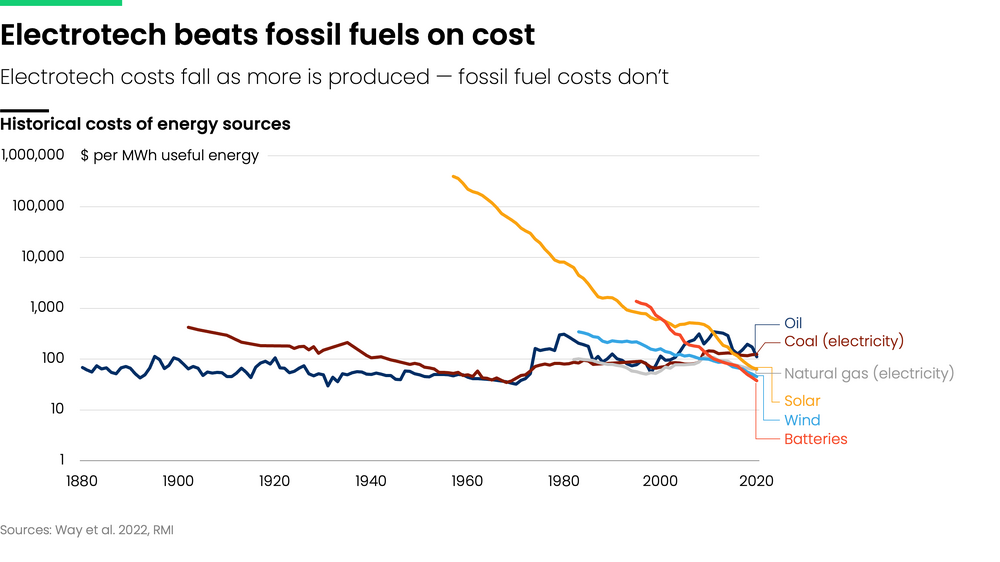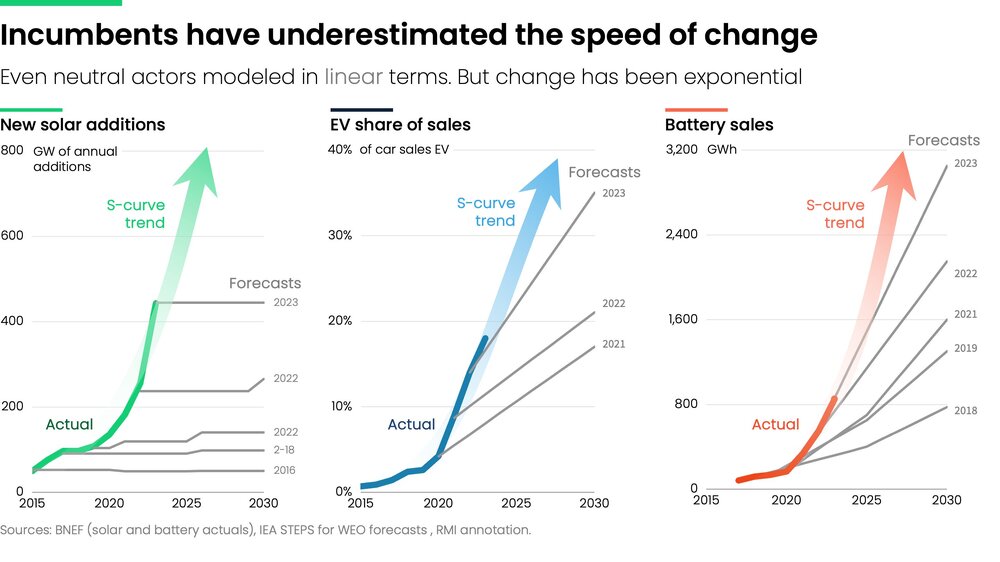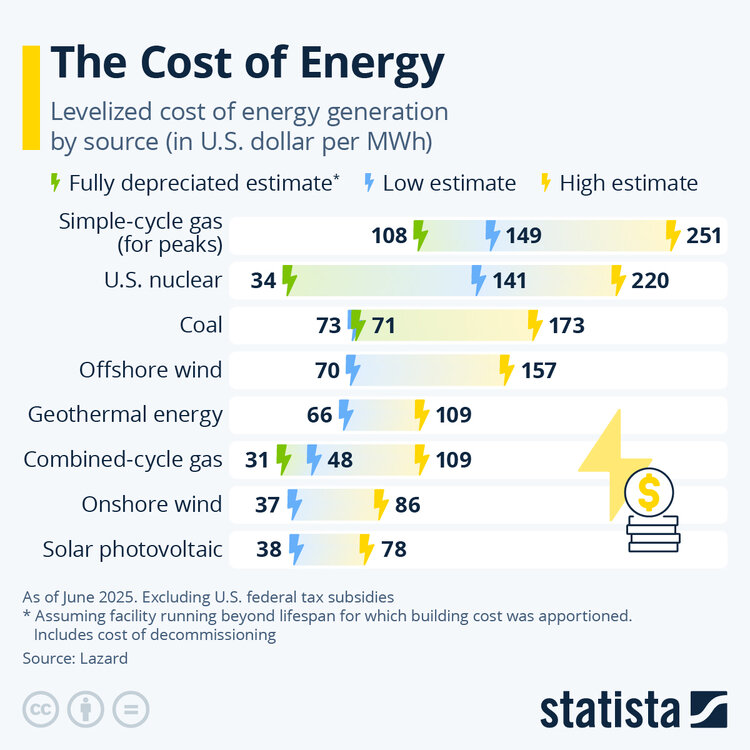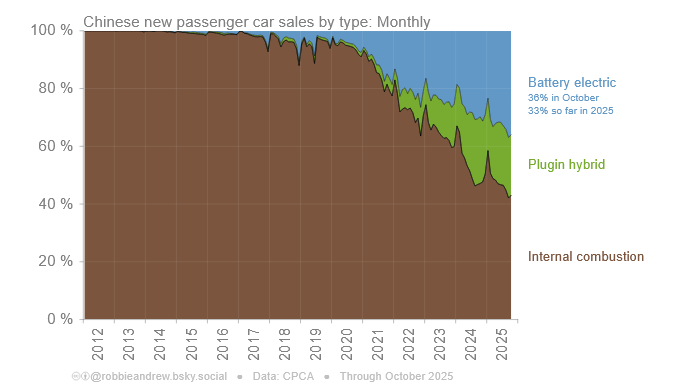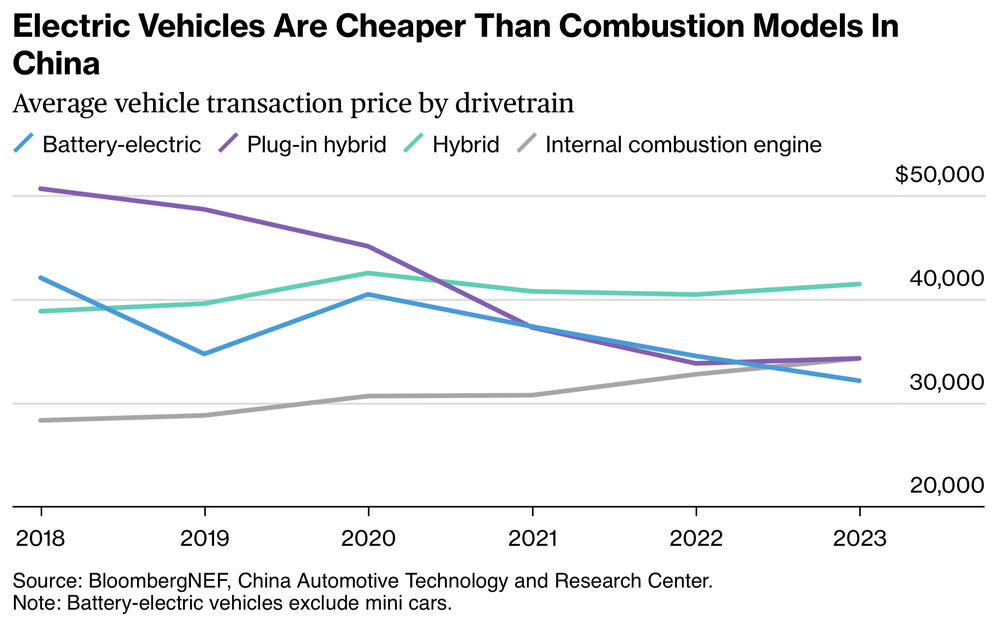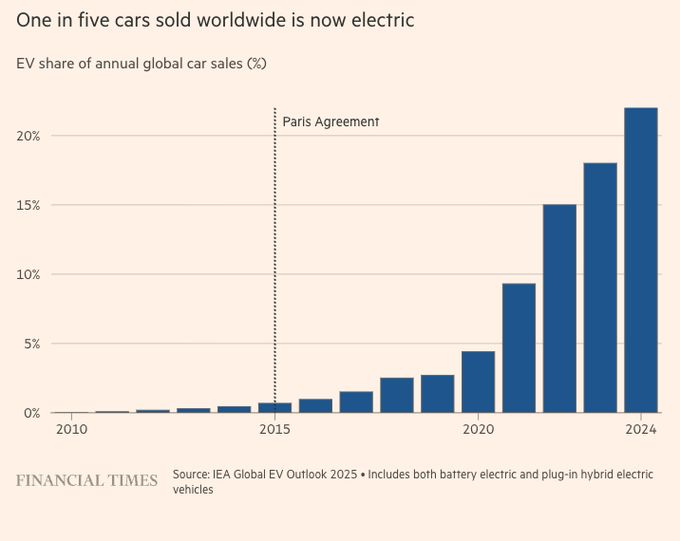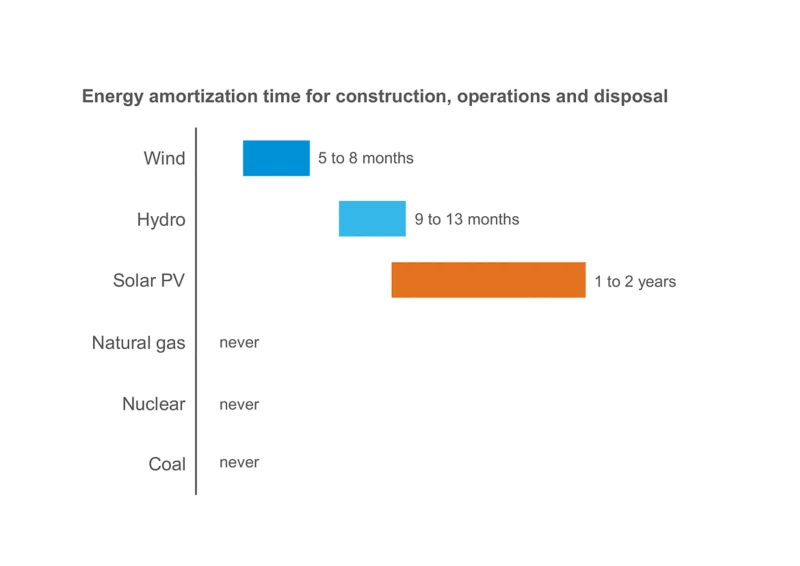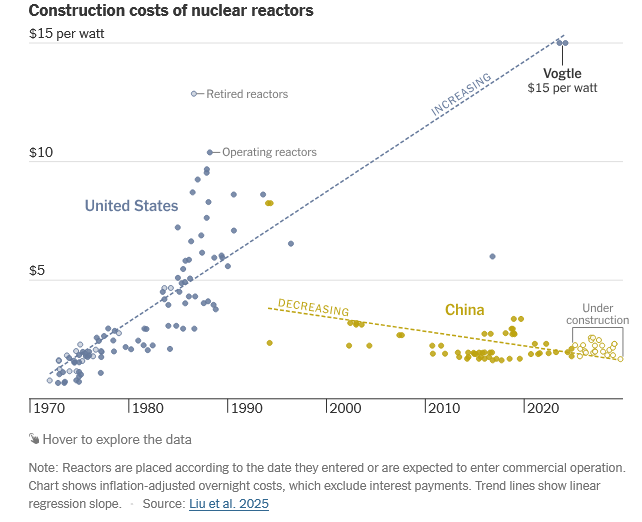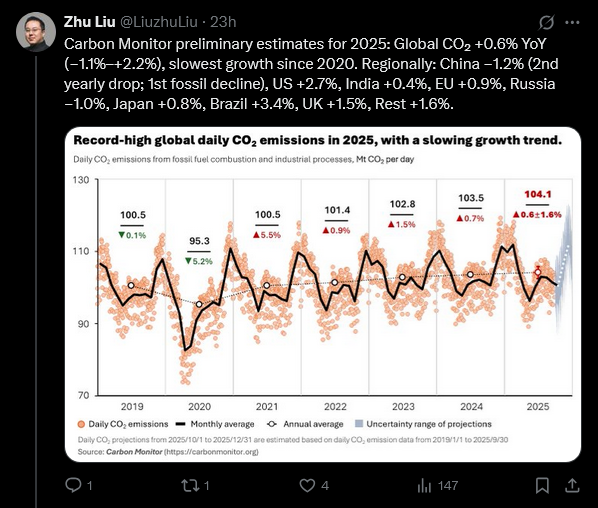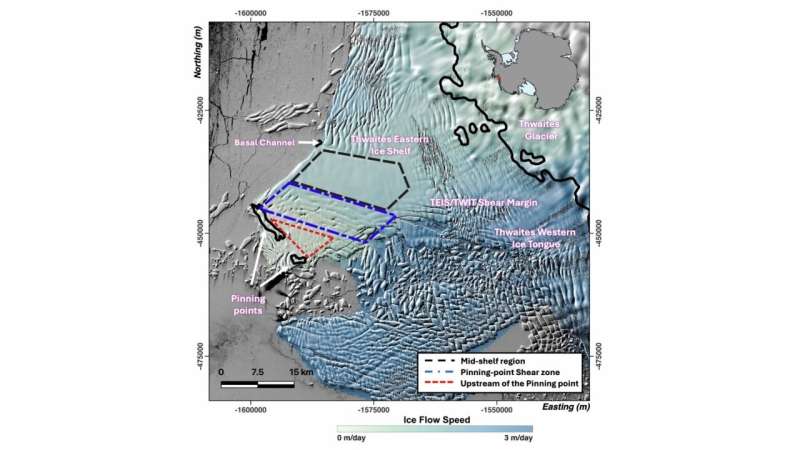
chubbs
Members-
Posts
4,059 -
Joined
-
Last visited
Content Type
Profiles
Blogs
Forums
American Weather
Media Demo
Store
Gallery
Everything posted by chubbs
-
Don't agree. Renewables are manufacturing technologies, like TVs or cellphones, and get cheaper as cumulative production increases. Subsidization was necessary and worthwhile while renewable cost was higher. The cost of the subsidies is minor vs the long-term benefits of sustainable, abundant, cheap and carbon-free energy. China has provided the largest subsidies and is reaping the largest benefits. We should have subsidized more not less. Renewables have already caught up with fossil fuels in cost and will only get better with time. The transition to renewables is accelerating and will take decades, not centuries. Its inevitable now that renewable costs are lower than fossil fuels. https://electrotechrevolution.substack.com/p/rewiring-the-energy-debate?utm_source=substack&utm_campaign=post_embed&utm_medium=web
-
Environmental impacts are a cost to society. Fossil fuels have been and largely still are getting a free ride on CO2 emissions. The typical coal or gas-fired power plant doesn't pay for its CO2 emissions. A big subsidy.
-
The plants that were being shutdown had relatively high cost, that's why they were being shutdown.
-
Long article on rapid introduction of electric HD trucks in China. China is upending fossil fuel economics: "The lesson for Western operators and policymakers is that the cost curve has shifted. The decisions that made sense even in 2024 do not match the realities of 2025." https://cleantechnica.com/2025/11/26/chinas-bev-trucks-and-the-end-of-diesels-dominance/
-
Don't agree with your comments. The article provided references. Other than fully depreciated gas and nuclear, Renewables are the lowest cost of electricity in the US. New gas plants, to meet increasing demand, will be much more expensive than fully depreciated; and, as the article states, costs and backlogs for new gas plants are increasing.
-
Data is available at link below. Glad to answer questions. https://ceres-tool.larc.nasa.gov/ord-tool/jsp/EBAFTOA421Selection.jsp
-
Ceres has updated through September. Net radiation continues to increase off the enso bottom and the 12-month average is getting close to peak levels in La Ninas before 2020.
-
Slowing down the introduction of renewables is going to increase US electricity prices. https://www.forbes.com/sites/ianpalmer/2025/11/23/electricity-prices-will-shoot-up-due-to-us-federal-mandates/?ctpv=xlrecirc
-
Plug-in hybrids, EVs with a back-up gas engine, are an additional roughly 20% in China. So conventional combustion cars have fallen below 50%. EV subsidies are being eliminated in China as they aren't needed anymore (see link). Agree China wouldn't have cheap EVs without subsidies. However, now that cheap EVS are here there is no going back. EVs are only going to get cheaper and better going forward as commercial scale increases and battery technology improves. China's big EV bet is paying off. Their EV exports are ramping, reaching a record $7 billion in August. (2nd link). https://www.reuters.com/business/autos-transportation/china-signals-it-will-pull-plug-subsidies-evs-with-five-year-plan-exclusion-2025-10-29/ https://ember-energy.org/data/china-cleantech-exports-data-explorer/
-
Agree that EV's are not out competing oil in the US. They are outcompeting in China though, and those cars will spread as volume production increases both in China and in plants being built by Chinese companies around the world.
-
A number of countries have increasing EV market share with the global share over 20% this year. Link below has EV and plug-in EV market penetration for 61 countries. There's a range between countries with the US and North America a relative low penetration area. Another growing EV market is Heavy-Duty trucks, which are ramping quickly in China (2nd link), reaching a 28% market share there in Aug 25. https://robbieandrew.github.io/carsales/ https://apnews.com/article/china-truck-lng-ev-diesel-transport-70f3d612de4b45b6f954a7f557f7f741
-
Yea he brought up some good points: our economy and life-style is currently dependent on oil, and oil is running out. However. he's wrong that there is no alternative. Electric vehicles are out competing combustion vehicles in an increasing number of markets and getting cheaper all the time. Meanwhile the best oil reserves are increasingly depleted. Its not going to get better for oil.
-
Believe the table is calculating electric energy out vs fossil energy in over the powerplant lifetime; i.e., coal (or gas, oil) used to generate power is included. Fossil fuel use during operation of the wind turbine is also included. Agree that society gets an energy payback from use of coal or oil. The problem is that once burned the coal it is gone forever. In-any-case wind has a good energy payback. Here's an extensive study from Europe covering 33 different kinds of turbines. The median payback period is 6 months. Note that the energy payback for wind has to be good. Its the cheapest source of electricity in windy areas like the great plains. If it didn't pay back it wouldn't be cheap. https://www.sciencedirect.com/science/article/abs/pii/S0196890421005100
-
An oil industry myth. The bigger the wind turbine the faster it pays out the energy needed to make it. Only 64 days for a 3.4 MW turbine https://pure.sruc.ac.uk/en/publications/life-cycle-analysis-of-the-embodied-carbon-emissions-from-14-wind/ https://www.vestas.com/en/sustainability/environment/energy-payback
-
I'm open to any non-fossil energy source, let the market decide. In the case of nuclear, the US will need to lower cost to deploy significant volume. https://www.nytimes.com/interactive/2025/10/22/climate/china-us-nuclear-energy-race.html?unlocked_article_code=1.vk8.p953.GyoqfHxUqxEK&smid=url-share
-
Cheap labor is only one part of the story. "China has close to 50 graduate programs that focus on either battery chemistry or the closely related subject of battery metallurgy. By contrast, only a handful of professors in the United States are working on batteries." https://www.business-standard.com/world-news/how-china-built-tech-prowess-chemistry-classes-and-research-labs-124081000019_1.html https://www.bbc.com/future/article/20251110-how-china-won-the-worlds-battery-race
-
"cheap labor" is an outdated stereotype. The factories producing solar/battery/ev are highly automated. China is kicking our butt in a wide range of advanced technologies. https://itif.org/publications/2025/09/23/how-china-is-outperforming-the-united-states-in-critical-technologies/
-
Yes, China is a good news, bad news story. China has gone from undeveloped under Chairman Mao to the dominant manufacturing country in the world. That takes energy and the main local fossil-fuel energy source is coal. In part, the developed world has outsourced their emissions to China through the import of manufactured goods. On the flip side, China has rapidly scaled non-fossil clean-energy technology. Driving costs below fossil fuels in many applications and thereby providing a clear path forward to a non-fossil future. It was a gamble on their part and it paid off big time. Now China exports of clean energy equipment provide a large boost to their economy and are reducing emissions around the world. For better or worse we have largely ceded our climate future to China. https://x.com/JessePeltan/status/1989006026520080519 https://bsky.app/profile/laurimyllyvirta.bsky.social/post/3m2jgeqa4es2z
-
My point was about technology and solar, not China. Let me rephrase. The problem isn't a lack of technology, its a lack of focus or desire (agreeing with Tip). Climate change isn't high enough on humanity's priority list, China included. I think the phase-out of fossil fuels is only a matter of time though. Unfortunately it won't come fast enough to avoid significant climate impacts. https://bsky.app/profile/laurimyllyvirta.bsky.social/post/3m5djg6evmc2l
-
I don't think the problem is technology. Solar has outperformed expectations for decades. Same for batteries. China has shown that solar can be deployed much faster than any competing energy technology. We could easily match as our solar resource is better than China's. No its the power of the incumbent, misinformation/denial, lack of vision, and geopolitics and others, that are allowing fossil-fuels to linger. https://x.com/JessePeltan/status/1988427201772245459
-
Yes, China's nuclear generation is increasing rapidly. They are also adding large amounts of hydro and wind. However their biggest source of their new non-fossil power is solar. The solar they are installing this year is roughly equivalent to the entire US nuclear fleet.
-
Preliminary data for this year, shows global CO2 emissions continue to plateau as clean energy technologies take most of the growth in global energy demand. However to solve climate change, need to see a drop in CO2 emissions, the faster the better. In other words progress on clean energy isn't fast enough as fossil incumbents resist change. This years data also shows a reversal in the CO2 growth trajectories of the two biggest emitters, US and China. China is embracing clean energy technologies while the US doubles down on fossil fuels.
-
Yes, there are a couple of underwater hills that pin the tip of the ice shelf in place (see chart) Per the article, the pinning points have transitioned from a stabilizing to a de-stabilizing force over the past 20 years.
-
New paper on the de-stabilization of the Thwaites ice shelf over the past 20 years. Video, linked below, provides a good overview of the changes to the ice shelf over the past 10 years. Other papers have projected the ice shelf's complete collapse by 2030. https://agupubs.onlinelibrary.wiley.com/doi/10.1029/2025JF008352 https://phys.org/news/2025-11-antarctic-doomsday-glacier-ice-shelf.html 10-year video https://scx2.b-cdn.net/gfx/video/2025/cracking-the-code-of-t.mp4
-
This board has taught me never to underestimate the power of confirmation bias.

